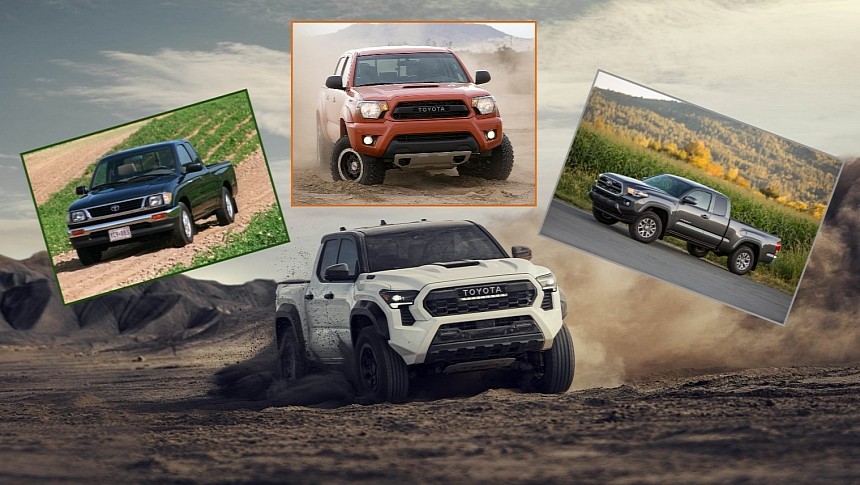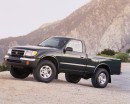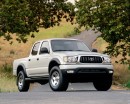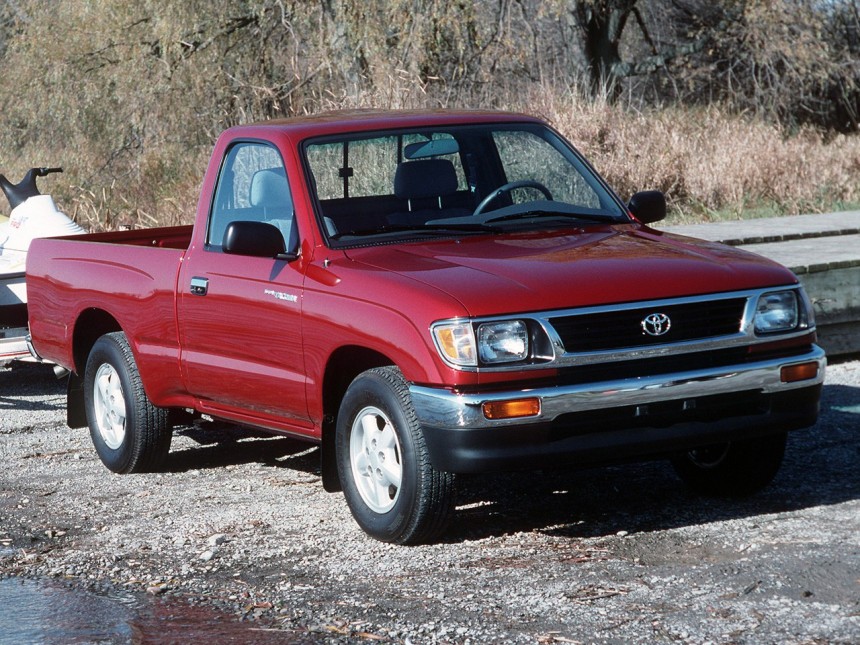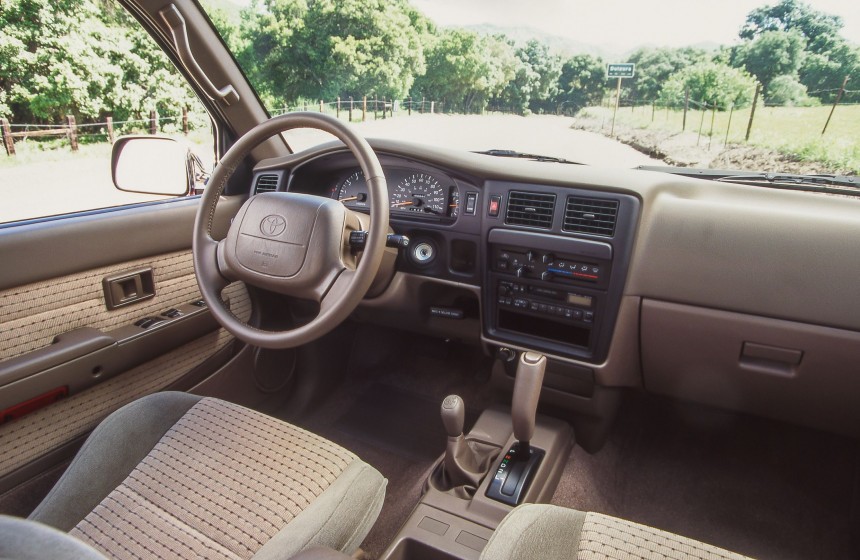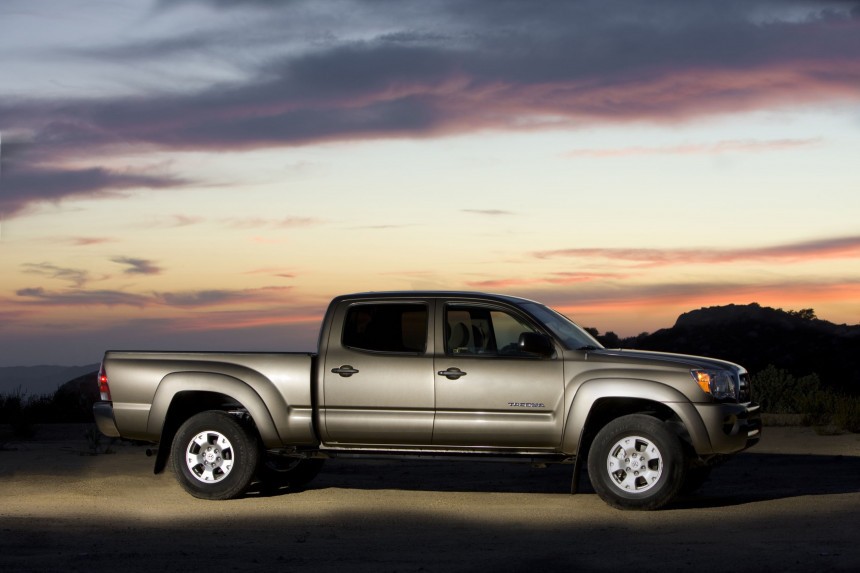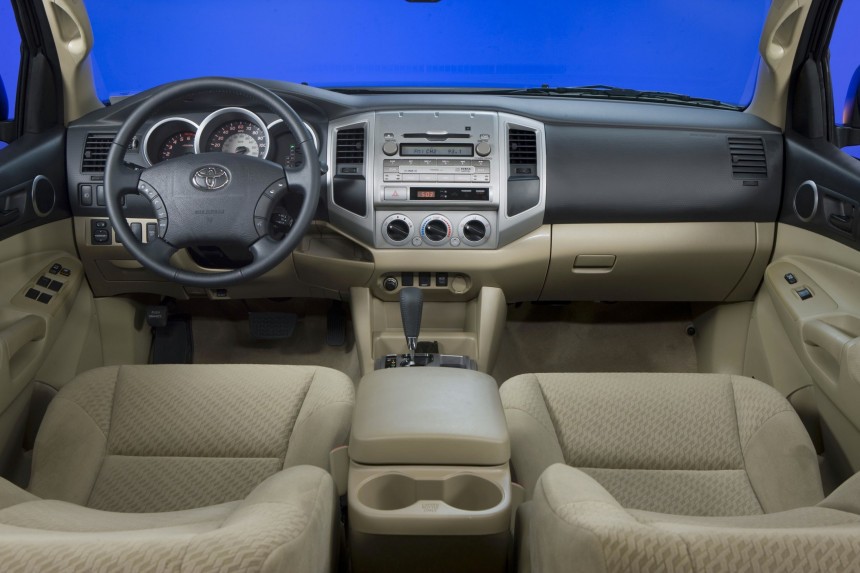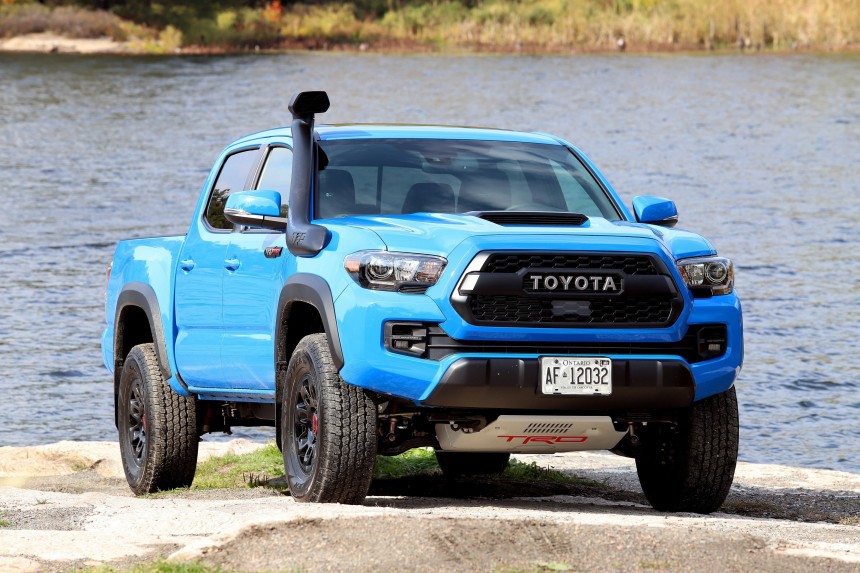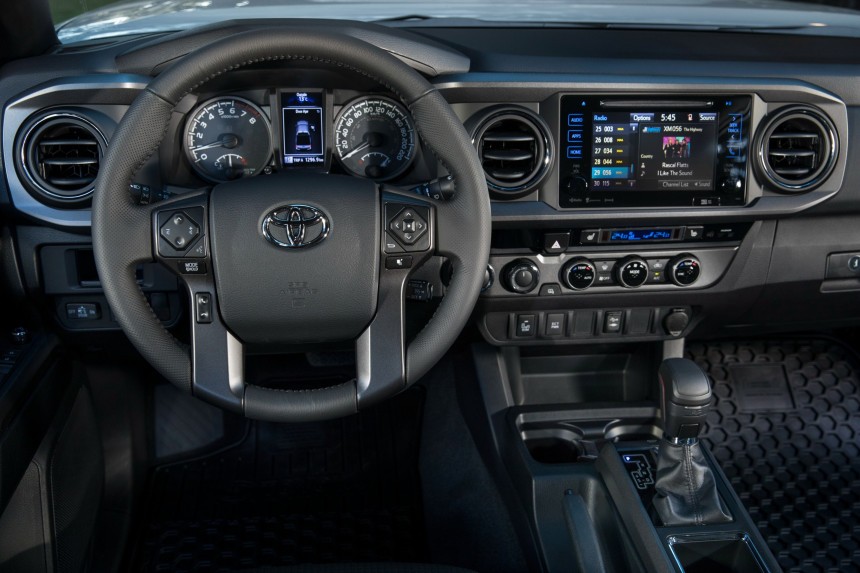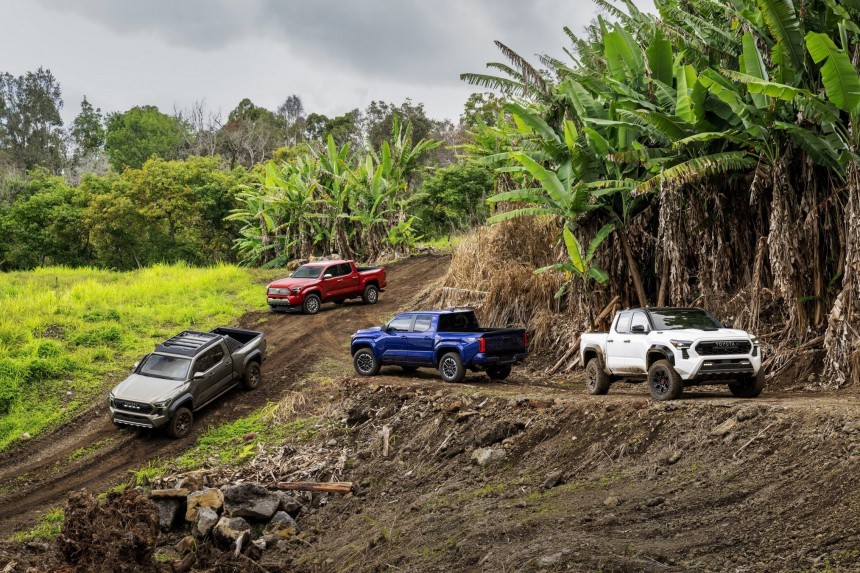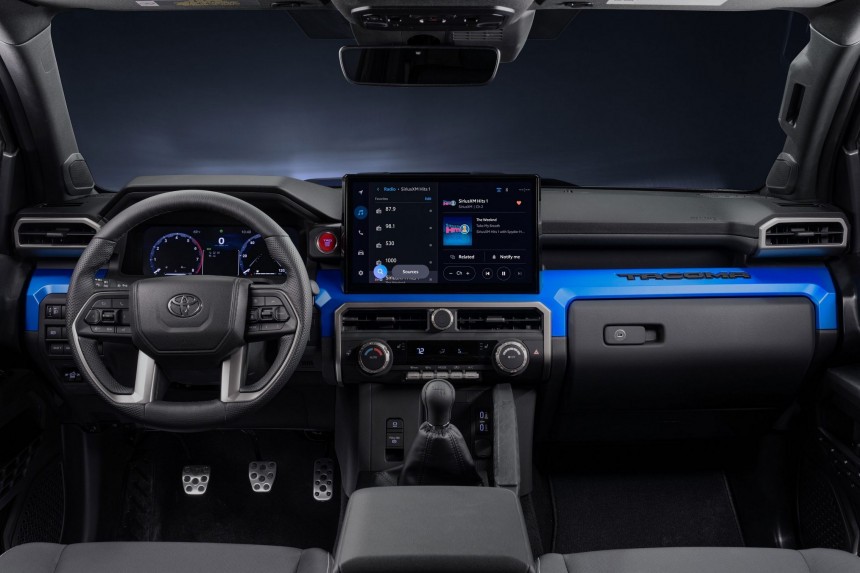Originally classified as a compact, the long-running Tacoma is the nation’s best-selling midsizer. How did it manage to beat Detroit’s Big Three automakers and Japanese competitors such as the Nissan Frontier and unibody Honda Ridgeline?
For starters, the Tacoma’s ancestry includes the Hilux (marketed as the Pickup in the US). Prior to the Hilux setting foot on American soil, Toyota sold the Stout with little in the way of commercial success in this part of the world. After all, small trucks weren’t all that popular back in the days of the muscle car and the 20-foot-long land yacht.
Named after the Coast Salish Indian word for Washington-based Mount Rainier, the Tacoma is popular for its higher-than-average resale value as well. But most importantly, people buy Tacos for their segment-leading reliability. For 2024, however, the mid-size truck’s reliability is expected to take a turn for the worse due to the TNGA-F platform of the Tundra. Add some hybridization to the mix, and you’ll understand why the fourth-gen Taco is a different animal from its predecessors.
Before going any further with this in-depth look at the Tacoma’s journey from promising newcomer to segment leader, it should be mentioned that more than 190,000 units have been sold in the US on a yearly basis since 2018. No fewer than 252,490 examples of the breed were delivered in 2021 alone. By comparison, Toyota sold a grand total of 89,967 units in calendar year 1995, which also marks the first year of issues for this highly praised truck.
What issues? First and foremost, in excess of 800,000 trucks were recalled in 2008 over inadequate rustproofing of the frame. Dealers were instructed to repair or buy back affected trucks at 1.5 times their estimated retail value. Later on, trucks found to be rusty beyond repair were treated to replacement frames at no cost to the customers.
Fast forward to 2012, and 150,000 trucks initially sold in cold-weather states were called back due to an insufficiently coated metal plate. What’s the matter with that? Well, the spare tire could fall off, resulting in a road hazard for the vehicles behind. Those are the biggest problems of the good ol’ Taco thus far, and – as opposed to certain automakers such as Ford – Toyota didn’t mess with its customers by presenting them with shoddy fixes.
That said, the first-gen Tacoma was commended by American motoring publications from day one. It was a huge thing for Toyota to develop a truck specifically for America, albeit a truck closely related to the sixth-generation Hilux. Penned by Kevin Hunter at the Japanese automaker’s CALTY design studio in California, the original Taco was facelifted twice: the first time in July 1997 for model year 1998, then in October 2000 for model year 2001.
The second refresh is credited to Yusuke Fukushima, a very talented gentleman who also worked on the design team responsible for the eighth-generation Hilux. For the 1995 (and a half) model year, the 4x2 Regular Cab with the 2.4-liter standard four-pot mill retailed at $11,848. Adjusted for inflation, that means $23,930 for the most barebone specification of the lot in today’s money. For reference, the 2023 model starts at $28,600 at the moment of writing this piece (October 2023).
4WD trucks got a 2.7er with 150 horsepower on deck, whereas the optional V6 was rated at 190 ponies. Toyota unleashed a Toyota Racing Development supercharger kit for the 3.4-liter engine for model year 1997, which boosted the six-cylinder lump to 262 horsepower. Originally available in Regular Cab and Xtracab flavors, the first-gen Tacoma received a Double Cab in 2001. Double cabs make up most truck sales – irrespective of segment – in the US market in this day and age.
Built on a fully-boxed frame as opposed to open C-section rails for the second generation, the highly coveted first gen came with a five-speed manual or a four-speed automatic. The TRD Off-Road Package was introduced back in 1998, whereas antilock brakes became standard equipment for model year 2003. When it comes to capability, towing capacity ranges from 3,500 pounds (make that 1,588 kilograms) to 5,000 pounds (2,268 kilograms). Payload, meanwhile, tops 2,005 pounds (909 kilograms) for the Regular Cab PreRunner 2WD with the 2.7-liter I4 and the four-speed auto.
As highlighted in the paragraph you’ve just finished reading, Toyota switched to a different frame design for the second generation. Shigeya Hattori and Hideo Karikomi produced the exterior design, Chikuo Kubota served as chief engineer, and most of the development work is credited to Toyota subsidiary Hino due to the company’s experience in all things commercial vehicles. Joined at the hip to the fourth-gen 4Runner and FJ Cruiser, the second coming of the Tacoma dropped the original’s 2.4-liter base four-cylinder powerplant.
From a mechanical standpoint, Toyota introduced a five-speed automatic and a six-speed manual. That’s not all, though, because this generation of the Tacoma sports the largest six-cylinder lump ever fitted to the Tacoma. Said engine is the 1GR-FE, a 4.0-liter V6 with either VVT-i or Dual VVT-i. For some reason or another, the 2005 to 2015 Tacoma has variable valve timing only for the intake valves. The FJ Cruiser rocked VVT-i from 2007 to 2009 as well, yet 2010 saw the switch to the better system.
The first gen was produced at the NUMMI assembly plant in Fremont, California, which is currently owned and operated by Tesla. Come 2004, the Tacoma also entered production at TMMBC in Mexico. The NUMMI assembly plant was sold to Tesla in 2010, the year Toyota inaugurated a new production line in Texas. While on the subject of where it’s made, the 2024 model year comes from Mexico exclusively.
A mid-size truck as opposed to its compact forerunner, the second-gen Tacoma Regular Cab measures 109.4 inches (2,779 millimeters) in wheelbase compared to 103.3 inches (2,624 millimeters) for the first. Given this change, it shouldn’t come as a surprise that the base curb weight also ballooned by approximately 350 pounds (159 kilograms) across the board. As a result, combined gas mileage dropped from a maximum rating of 22 miles per gallon (10.7 liters per 100 kilometers) to a high of 21 mpg (11.2 l/100 km).
Capable of towing up to 6,500 pounds (2,948 kilograms), this generation was available in 18 distinct configurations. Toyota sweetened the deal with more standard goodies than ever before, with an emphasis on safety. From brake assist to traction control, electronic brake force distribution, active headrests, and side curtain airbags, it was the bee’s knees for a mid-size pickup truck from that era.
Once more with a feeling, the V6 could be fitted with a TRD-branded supercharger. Every single version of the second-gen Taco was built with a made-in-Mexico composite bed. The full-size Tundra switched to composite in 2022 with the introduction of the highly polarizing third generation, which dropped the preceding naturally-aspirated V8 in favor of a twin-turbo V6 engine.
The N220/N240/N250/N260/N270 sold very well, topping over 170,000 deliveries in the United States in 2006 and 2007. But with the introduction of the N300, the Tacoma shot up to 191,631 sales in 2016. As underlined a few paragraphs earlier, the third-gen Taco crossed the 250,000 mark in calendar year 2021. A magnificent improvement in every respect, especially if you remember that fullsizers make up most truck sales in the United States of America.
Revealed with much pomp in January 2015 at the North American International Auto Show in Detroit, the third generation was often described as a paradigm shift. In hindsight, Toyota improved on the Tacoma’s winning formula without making any bold changes whatsoever. Looking at you, fourth-gen Tacoma with all-turbo I4 engines, a hybrid option, and front seats with air-adjustable shocks!
At the time of the third generation’s unveiling, the Tacoma enjoyed more than 60 percent market share. In the last year of the second gen, the midsizer outsold its closest competitor (the Nissan Frontier) two to one. Back then, the mid-size pickup truck segment comprised five nameplates: those two, the Chevrolet Colorado and GMC Canyon from General Motors, and the Pilot-based Honda Ridgeline. In 2014, the Tacoma moved 155,041 units versus 74,323 copies of the Frontier. By comparison, the F-Series and Silverado ended 2014 with 753,851 and 529,755 deliveries.
What made the third-gen Tacoma more popular than the first two generations? Toyota understood that every truck owner out there spends more time inside than looking at said truck’s bodywork. In addition to the heavily revised cabin (with distinctive looks for every trim level from the SR to the Limited), the Tacoma’s cabin structure was reinforced (especially at the A and B pillars) for superior crash protection. Even though bed widths hadn’t changed from the 2015 model, the 2016 features higher (by 1.1 inches) and longer (by 0.2 inches) cargo boxes.
Supporting both the carryover 2.7 and 4.0-replacing 3.5er, a six-speed automatic with a 6.21 ratio spread further improved the Tacoma’s appeal. The 2GR-FKS nets a 42-horsepower advantage over its predecessor, yet it’s down one pound-foot of torque. Even so, it averages up to 21 miles per gallon (11.2 liters per 100 kilometers) as opposed to 19 mpg (12.4 l/100 km) for the 4.0 of the second gen. The gross vehicle weight and gross combined weight ratings have also gone up to 5,600 pounds (2,540 kilograms) and 11,360 pounds (5,152 kilograms) across the board. The 2015 model, by comparison, was rated at up to 5,500 and 11,100 (2,495 and 5,035).
Be that as it may, the Regular Cab didn’t return for 2016 (it was discontinued after the 2014 model year due to increasingly poor sales). The iron-block 2.7er isn’t anything to write home about either. Similar to the N280-series 4Runner, the N300 also received plenty of criticism for the reduced steering wheel controls functionality. Toyota redeemed itself for the 2018 model year. The mid-cycle redesign followed suit for 2020, which added wired Apple CarPlay, Android Auto, and even Amazon Alexa.
And now for the big one: a completely new Tacoma for 2024! Arguably the most ambitious midsizer in the US at press time, the 2024 model year Tacoma is nut-and-bolt different from its highly successful forebear. Internally referred to as N400, the fourth generation is one of only two pickup trucks with an available manual transmission for 2024. Care to guess which is the other? Of course, the answer comes in the form of Jeep’s newly refreshed Gladiator (with the 3.6-liter Pentastar V6 engine).
Picking the three-pedal transmission comes with small penalties in power and torque, though. The numbers are 270 horsepower and 310 pound-feet (420 Nm), down 8 and 7 from the eight-speed automatic. The row-your-own transmission is limited to the SR Double Cab, TRD Sport Double Cab, and TRD Off-Road Double Cab. Two more things about said manual: not only does it have automatic rev matching, but the automaker also included anti-stall tech for extra peace of mind.
The most basic specification available is the SR Extended Cab, which – surprisingly enough – is automatic. This fellow belts out 228 horsepower and 243 pound-feet (329 Nm) at full chatter, which is better than the old 2.7’s 159 horsepower and 180 pound-feet (244 Nm). At the other end of the spectrum, the automatic-only hybrid version of the i-FORCE makes 326 ponies and 465 pound-feet (630 Nm) of twist.
Torquier than the Colorado’s high-output 2.7 turbo I4 (430 pound-feet or 569 Nm) and the Ranger Raptor’s twin-turbo V6 (also 430 pound-feet), the i-FORCE MAX is available for three grades (TRD Sport, TRD Off-Road, Limited) and standard for the halo grades (TRD Pro and Trailhunter). Previewed by the Tundra-based Trailhunter concept from the 2022 SEMA Show, the Tacoma Trailhunter is the rock-crawling brother of the TRD Pro.
The Limited is focused on plushness, with its primary rival being the GMC Canyon Denali (available from $52,495 according to the build & price tool as of October 2023). 33-inch Goodyear Territory R/Ts are optional on the TRD Off-Road, yet come standard on the Trailhunter and TRD Pro. For reference, the Colorado ZR2 has 35s. The biggest tires in the segment, however, are 37s for the Gladiator Rubicon with the Level II upfit from AEV.
Rated at 6,500 pounds (2,948 kilograms) for maximum towing capacity and 1,709 pounds (775 kilograms) for maximum payload capacity, the fourth-gen Tacoma boasts 7 percent more bed cargo volume, the Toyota Safety Sense 3.0 suite of safety systems, and front stabilizer bar disconnect (optional on the TRD Off-Road, yet standard on the TRD Pro). Pricing starts at $31,500 sans destination for the work-oriented SR. By comparison, the 2023 model year SR Access Cab 2WD is $28,600.
Named after the Coast Salish Indian word for Washington-based Mount Rainier, the Tacoma is popular for its higher-than-average resale value as well. But most importantly, people buy Tacos for their segment-leading reliability. For 2024, however, the mid-size truck’s reliability is expected to take a turn for the worse due to the TNGA-F platform of the Tundra. Add some hybridization to the mix, and you’ll understand why the fourth-gen Taco is a different animal from its predecessors.
Before going any further with this in-depth look at the Tacoma’s journey from promising newcomer to segment leader, it should be mentioned that more than 190,000 units have been sold in the US on a yearly basis since 2018. No fewer than 252,490 examples of the breed were delivered in 2021 alone. By comparison, Toyota sold a grand total of 89,967 units in calendar year 1995, which also marks the first year of issues for this highly praised truck.
Toyota Tacoma Generation 1 (model years 1995 to 2004)
Fast forward to 2012, and 150,000 trucks initially sold in cold-weather states were called back due to an insufficiently coated metal plate. What’s the matter with that? Well, the spare tire could fall off, resulting in a road hazard for the vehicles behind. Those are the biggest problems of the good ol’ Taco thus far, and – as opposed to certain automakers such as Ford – Toyota didn’t mess with its customers by presenting them with shoddy fixes.
That said, the first-gen Tacoma was commended by American motoring publications from day one. It was a huge thing for Toyota to develop a truck specifically for America, albeit a truck closely related to the sixth-generation Hilux. Penned by Kevin Hunter at the Japanese automaker’s CALTY design studio in California, the original Taco was facelifted twice: the first time in July 1997 for model year 1998, then in October 2000 for model year 2001.
4WD trucks got a 2.7er with 150 horsepower on deck, whereas the optional V6 was rated at 190 ponies. Toyota unleashed a Toyota Racing Development supercharger kit for the 3.4-liter engine for model year 1997, which boosted the six-cylinder lump to 262 horsepower. Originally available in Regular Cab and Xtracab flavors, the first-gen Tacoma received a Double Cab in 2001. Double cabs make up most truck sales – irrespective of segment – in the US market in this day and age.
Built on a fully-boxed frame as opposed to open C-section rails for the second generation, the highly coveted first gen came with a five-speed manual or a four-speed automatic. The TRD Off-Road Package was introduced back in 1998, whereas antilock brakes became standard equipment for model year 2003. When it comes to capability, towing capacity ranges from 3,500 pounds (make that 1,588 kilograms) to 5,000 pounds (2,268 kilograms). Payload, meanwhile, tops 2,005 pounds (909 kilograms) for the Regular Cab PreRunner 2WD with the 2.7-liter I4 and the four-speed auto.
Toyota Tacoma Generation 2 (model years 2005 to 2015)
From a mechanical standpoint, Toyota introduced a five-speed automatic and a six-speed manual. That’s not all, though, because this generation of the Tacoma sports the largest six-cylinder lump ever fitted to the Tacoma. Said engine is the 1GR-FE, a 4.0-liter V6 with either VVT-i or Dual VVT-i. For some reason or another, the 2005 to 2015 Tacoma has variable valve timing only for the intake valves. The FJ Cruiser rocked VVT-i from 2007 to 2009 as well, yet 2010 saw the switch to the better system.
The first gen was produced at the NUMMI assembly plant in Fremont, California, which is currently owned and operated by Tesla. Come 2004, the Tacoma also entered production at TMMBC in Mexico. The NUMMI assembly plant was sold to Tesla in 2010, the year Toyota inaugurated a new production line in Texas. While on the subject of where it’s made, the 2024 model year comes from Mexico exclusively.
Capable of towing up to 6,500 pounds (2,948 kilograms), this generation was available in 18 distinct configurations. Toyota sweetened the deal with more standard goodies than ever before, with an emphasis on safety. From brake assist to traction control, electronic brake force distribution, active headrests, and side curtain airbags, it was the bee’s knees for a mid-size pickup truck from that era.
Once more with a feeling, the V6 could be fitted with a TRD-branded supercharger. Every single version of the second-gen Taco was built with a made-in-Mexico composite bed. The full-size Tundra switched to composite in 2022 with the introduction of the highly polarizing third generation, which dropped the preceding naturally-aspirated V8 in favor of a twin-turbo V6 engine.
Toyota Tacoma Generation 3 (model years 2016 to 2023)
Revealed with much pomp in January 2015 at the North American International Auto Show in Detroit, the third generation was often described as a paradigm shift. In hindsight, Toyota improved on the Tacoma’s winning formula without making any bold changes whatsoever. Looking at you, fourth-gen Tacoma with all-turbo I4 engines, a hybrid option, and front seats with air-adjustable shocks!
At the time of the third generation’s unveiling, the Tacoma enjoyed more than 60 percent market share. In the last year of the second gen, the midsizer outsold its closest competitor (the Nissan Frontier) two to one. Back then, the mid-size pickup truck segment comprised five nameplates: those two, the Chevrolet Colorado and GMC Canyon from General Motors, and the Pilot-based Honda Ridgeline. In 2014, the Tacoma moved 155,041 units versus 74,323 copies of the Frontier. By comparison, the F-Series and Silverado ended 2014 with 753,851 and 529,755 deliveries.
Supporting both the carryover 2.7 and 4.0-replacing 3.5er, a six-speed automatic with a 6.21 ratio spread further improved the Tacoma’s appeal. The 2GR-FKS nets a 42-horsepower advantage over its predecessor, yet it’s down one pound-foot of torque. Even so, it averages up to 21 miles per gallon (11.2 liters per 100 kilometers) as opposed to 19 mpg (12.4 l/100 km) for the 4.0 of the second gen. The gross vehicle weight and gross combined weight ratings have also gone up to 5,600 pounds (2,540 kilograms) and 11,360 pounds (5,152 kilograms) across the board. The 2015 model, by comparison, was rated at up to 5,500 and 11,100 (2,495 and 5,035).
Be that as it may, the Regular Cab didn’t return for 2016 (it was discontinued after the 2014 model year due to increasingly poor sales). The iron-block 2.7er isn’t anything to write home about either. Similar to the N280-series 4Runner, the N300 also received plenty of criticism for the reduced steering wheel controls functionality. Toyota redeemed itself for the 2018 model year. The mid-cycle redesign followed suit for 2020, which added wired Apple CarPlay, Android Auto, and even Amazon Alexa.
Toyota Tacoma Generation 4 (model year 2024 and beyond)
Picking the three-pedal transmission comes with small penalties in power and torque, though. The numbers are 270 horsepower and 310 pound-feet (420 Nm), down 8 and 7 from the eight-speed automatic. The row-your-own transmission is limited to the SR Double Cab, TRD Sport Double Cab, and TRD Off-Road Double Cab. Two more things about said manual: not only does it have automatic rev matching, but the automaker also included anti-stall tech for extra peace of mind.
The most basic specification available is the SR Extended Cab, which – surprisingly enough – is automatic. This fellow belts out 228 horsepower and 243 pound-feet (329 Nm) at full chatter, which is better than the old 2.7’s 159 horsepower and 180 pound-feet (244 Nm). At the other end of the spectrum, the automatic-only hybrid version of the i-FORCE makes 326 ponies and 465 pound-feet (630 Nm) of twist.
The Limited is focused on plushness, with its primary rival being the GMC Canyon Denali (available from $52,495 according to the build & price tool as of October 2023). 33-inch Goodyear Territory R/Ts are optional on the TRD Off-Road, yet come standard on the Trailhunter and TRD Pro. For reference, the Colorado ZR2 has 35s. The biggest tires in the segment, however, are 37s for the Gladiator Rubicon with the Level II upfit from AEV.
Rated at 6,500 pounds (2,948 kilograms) for maximum towing capacity and 1,709 pounds (775 kilograms) for maximum payload capacity, the fourth-gen Tacoma boasts 7 percent more bed cargo volume, the Toyota Safety Sense 3.0 suite of safety systems, and front stabilizer bar disconnect (optional on the TRD Off-Road, yet standard on the TRD Pro). Pricing starts at $31,500 sans destination for the work-oriented SR. By comparison, the 2023 model year SR Access Cab 2WD is $28,600.
